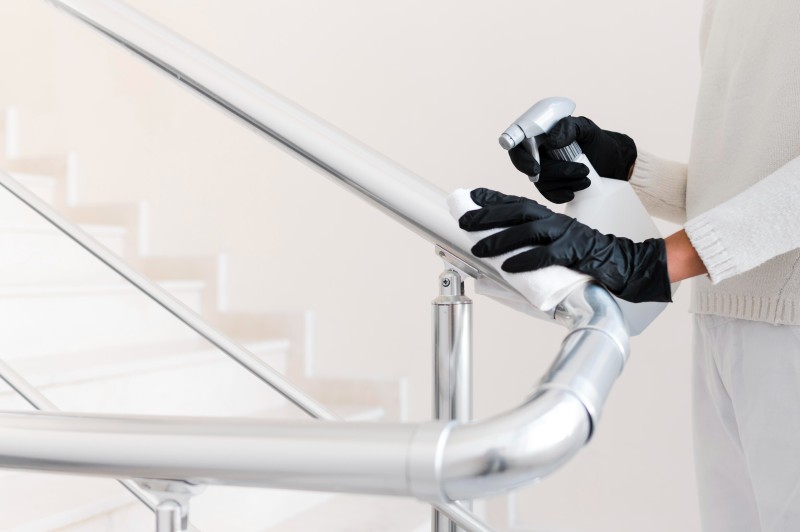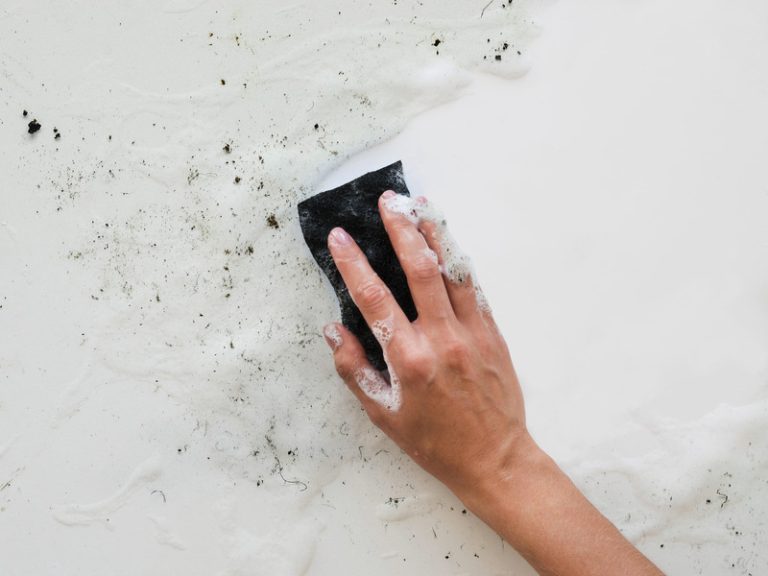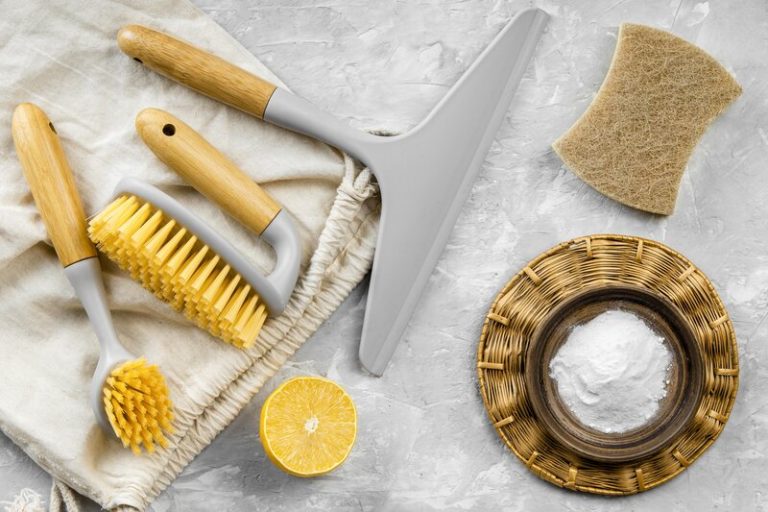Stainless steel is a stylish and durable choice for kitchens and appliances, making it a staple in modern homes. However, knowing how to disinfect stainless steel properly is essential for maintaining hygiene and ensuring a gleaming finish. Regular cleaning not only keeps surfaces looking pristine but also helps eliminate harmful germs and bacteria that can thrive in kitchens.
This article will guide you through effective methods for disinfecting stainless steel, including the best cleaning products to use, such as dish soap, vinegar, and microfibre cloths. We’ll also share tips on what to avoid, such as bleach and hard water, which can damage the surface.
With the right techniques, you can effortlessly maintain the shine of your stainless steel surfaces while keeping your home safe and healthy. Say goodbye to dull and dirty stainless steel and hello to a spotless, polished finish!
The Safest and Easiest Ways to Disinfect Stainless Steel
The safest and easiest ways to disinfect stainless steel include using common household products such as:
a. Using Soap and Water
Using soap and warm water is one of the simplest ways to disinfect stainless steel surfaces, effectively removing dirt, grease, and germs. Mix a few drops of washing-up liquid with warm water and apply with a microfibre cloth for a streak-free finish. This safe method promotes hygiene and helps to eliminate harmful bacteria, making it an ideal choice for learning how to disinfect stainless steel.
b. Using Vinegar
Vinegar is a natural disinfectant that effectively cleans stainless steel surfaces due to its acidic properties. Spray white vinegar or mix it with warm water for a powerful cleaning solution that disinfects while removing limescale and soap scum. For best results, wipe the surface in the direction of the grain, ensuring a streak-free shine and effective disinfection.
c. Using Rubbing Alcohol
Rubbing alcohol is an effective disinfectant for stainless steel, quickly eliminating germs without leaving streaks. Mix it with water in a 1:1 ratio for optimal performance. Apply with a microfibre cloth and wipe in the direction of the grain. This method not only sanitises surfaces but also dries quickly, making it a popular choice for those looking to maintain cleanliness and learn how to disinfect stainless steel.
d. Using Hydrogen Peroxide
Hydrogen peroxide is an excellent disinfectant for stainless steel, effectively killing bacteria and viruses on contact. Use a 3% solution by spraying or pouring it directly onto the surface and allowing it to sit for 5-10 minutes. This method not only disinfects but also helps remove stubborn stains, making it ideal for maintaining the pristine look of your stainless steel items.
Tips and Tricks for Disinfecting Stainless Steel
To effectively disinfect stainless steel surfaces, it’s essential to follow some helpful tips and tricks that ensure optimal cleanliness while preserving the material’s shine, some of which are:
a. Use a Microfiber Cloth
Using a microfiber cloth is ideal for cleaning stainless steel, as its fine fibres trap dirt and germs without scratching the surface. This method ensures your appliances remain shiny while being thoroughly sanitised. Microfiber excels over traditional materials, reaching tiny crevices and eliminating the need for harsh chemicals, making it both effective and eco-friendly.
b. Avoid Abrasive Cleaners and Polish Carefully
Avoid abrasive cleaners when disinfecting stainless steel, as they can scratch and dull the surface. Instead, opt for gentle cleaning solutions that effectively kill germs without damaging the material. Harsh chemicals can create micro-scratches, becoming breeding grounds for bacteria. Choose pH-balanced or natural alternatives, such as distilled vinegar, to maintain cleanliness and surface integrity.
c. Rinse Thoroughly
Thoroughly rinsing stainless steel surfaces after disinfecting is essential to remove any residue that may cause streaks or attract dirt. This step ensures your kitchen and bathroom appliances remain clean and shiny. Proper rinsing extends the lifespan of stainless steel by preventing tarnishing and corrosion, promoting better hygiene and overall cleanliness.
d. Dry with a Soft Cloth
After cleaning, drying stainless steel surfaces with a soft cloth prevents streaks and water spots. A soft cloth absorbs moisture effectively, ensuring your appliances maintain their polished appearance. For best results, use microfiber or lint-free cloths and wipe in a circular motion, promoting even drying while avoiding product residues that contribute to streaking.
What Not to Do When Disinfecting Stainless Steel?
When disinfecting stainless steel, there are several common mistakes that should be avoided to ensure the longevity and appearance of the material, including:
a. Use Bleach or Ammonia-based Cleaners
Bleach and ammonia-based cleaners should not be used on stainless steel, as they can cause irreparable damage and discoloration. Instead, opt for gentler disinfectants to effectively eliminate germs while preserving the material’s integrity. Solutions like vinegar and water, baking soda paste, or eco-friendly commercial cleaners are excellent alternatives for learning how to disinfect stainless steel safely.
b. Use Steel Wool or Abrasive Brushes
Using steel wool or abrasive brushes can scratch and damage stainless steel surfaces, increasing the risk of rust. Soft cloths or non-abrasive sponges are recommended for cleaning. Microfibre cloths effectively wipe down surfaces without scratching, while mild soap and water can remove dirt. Avoiding abrasive tools helps maintain the material’s sleek finish and lustre.
c. Leave Standing Water on the Surface
Leaving standing water on stainless steel can lead to rust and corrosion, compromising durability and appearance. Always wipe off excess moisture after cleaning to prevent oxidation and spotting. Prolonged exposure to water can lead to mineral stains and structural weaknesses. Regularly check for moisture accumulation to preserve the longevity of your stainless steel items.
How to Maintain the Disinfection of Stainless Steel?
Maintaining the disinfection of stainless steel requires a consistent cleaning routine and proper care to ensure its surface remains hygienic and visually appealing, among other things:
a. Regularly Clean and Disinfect the Surface
Regular cleaning and disinfecting of stainless steel surfaces is essential for hygiene, especially in kitchens and bathrooms where germs thrive. Establishing a consistent schedule helps eliminate harmful bacteria.
For effective maintenance, consider daily cleaning to prevent grime, weekly deep cleans for high-touch areas, and monthly extensive cleaning for appliances. This routine is key in learning how to disinfect stainless steel effectively.
b. Use a Stainless Steel Cleaner and Polish
Utilising a specialised stainless steel cleaner and polish significantly enhances the appearance and longevity of your appliances while maintaining a disinfected surface. These products remove fingerprints, smudges, and residues without damaging the material.
Regular application not only rejuvenates the surface but also eliminates harmful bacteria, ensuring a safe environment for food preparation and enhancing the aesthetic appeal of your kitchen.
c. Wipe Away Spills and Stains Immediately
Promptly wiping away spills and stains is vital for maintaining the appearance and hygiene of stainless steel surfaces. Allowing substances to sit can lead to tough stains and corrosion. For instance, spills like oil or vinegar can mar the finish and cause rust. By cleaning immediately with mild detergents and soft cloths, you can prevent long-term damage and keep your appliances looking their best.
Understanding how to disinfect stainless steel is crucial for maintaining a hygienic kitchen environment. While you can achieve a clean surface with the right products and techniques, professional cleaning can take your maintenance routine to the next level.
Instead of risking ineffective cleaning methods, why not entrust this task to the experts at TEKA Cleaning? Our specialised cleaning services are designed to provide a deep clean that not only ensures the shine and longevity of your stainless steel surfaces but also effectively eliminates germs and bacteria.
Don’t compromise on hygiene—contact us at 01223 751 544 to schedule your specialised cleaning service today. Experience the difference that professional care can make and create a healthier, more inviting kitchen space for you and your family! Your satisfaction and peace of mind are just a call away!
Read also:











